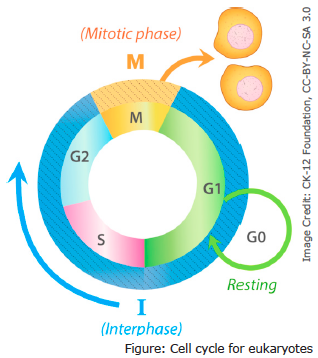Reading: Study Guide
Big Picture
The cell cycle is the life cycle of a cell. A cell spends its life growing, replicating DNA, performing other life functions, and dividing. For eukaryotic cells, the cell cycle consists of two general phases: interphase and the mitotic phase. Cell division is part of the life cycle for almost every cell. It is a more complicated process in eukaryotic than prokaryotic cells. Eukaryotes have multiple chromosomes and many organelles, all of which must be duplicated and separated for the cell to divide.Key Terms
Mitosis: Process in which the nucleus of a eukaryotic cell divides.
Prophase: First phase of mitosis during which chromatin condense into chromosomes, the nuclear envelope breaks down, centrioles separate, and a spindle begins to form.
Metaphase: Second phase of mitosis during which chromosomes line up at the equator of the cell.
Anaphase: Third phase of mitosis during which sister chromatids separate and move to opposite poles of the cell.
Telophase: Last stage of mitosis during which chromosomes uncoil to form chromatin, the spindle breaks down, and new nuclear membranes form.
Cytokinesis: Splitting of the cytoplasm to form daughter cells when a cell divides.
Chromatin: Grainy material that DNA forms when it is not coiled into chromosomes.
Chromosome: Coiled structure made of DNA and proteins containing sister chromatids that is the form the genetic material of a cell goes through cell division.
Chromatid: One of two identical copies of a chromosome that are joined together at a centromere be-fore a cell divides.
Centromere: Region of sister chromatids where they are joined together.
Homologous Chromosomes: Pair of chromosomes that have the same size and shape and contain the same genes.
Metaphase Plate: The invisible line at the equator (center) of the cell where the chromosomes containing the sister chromatids line up during metaphase.
Cell Plate: The structure that forms during cytokinesis in plants and eventually leads to the plasma membrane and cell wall of the two daughter plants.
Cell Cycle
Interphase
Interphase includes the growth phase 1 (G1), synthesis phase (S), and growth phase 2 (G2). A phase out of the cell cycle is G0, which the cell enters when it needs to rest temporarily or reaches a point in its life when it can no longer replicate.Mitotic Phase
A key part of cell division is to create copies of the genetic material.
The mitotic phase includes mitosis and cytokinesis.
• Mitosis is a multi-step process in which the nucleus of the cell divides.
• Cytokinesis, which comes after mitosis, is the division of the cytoplasm to create two daughter
cells.

Chromatin, Chromosome, and Chromatid
Part
of cell division is the replication and division of the genetic
material. There are different names for the genetic material depending
on the form it takes. It’s important to know the differences between
these terms. Make sure you understand when to use each term!
Chromatin
• Uncoiled strand of DNA wrapped around proteins called histones; the form DNA takes when the cell is not dividing.
Chromosome
• DNA condensed into a transportable form after it has replicated; since DNA has replicated, each chromosome contains two identical copies.
Sister chromatids
• The identical copies of DNA attached to each other by the centromere.
Homologous chromosomes
• A pair of chromosomes where the two chromosomes are of the same size and shape and contain the same genes, with each parent contributing one of the chromosomes in the pair.
Binary Fission
Most prokaryotic
cells divide by binary fission. Binary fission has three steps: 
Mitosis
In eukaryotes, after the cell has grown large enough to divide, it enters mitosis. There are several steps in mitosis:
3) Anaphase
4) Telophase


People Make A Team
Cytokinesis
Cytokinesis occurs differently for animal cells and plant cells. For animal cells, a cleavage furrow forms and the cytoplasm pinches inwards until two daughter cells are formed. The process is called cleavage. For plant cells, a cell plate forms in the middle of the cell, and then a new plasma membrane and cell wall forms.

If you want to remember the six main steps of cell division, use this mnemonic:
Interesting People Make A Team Cooler
